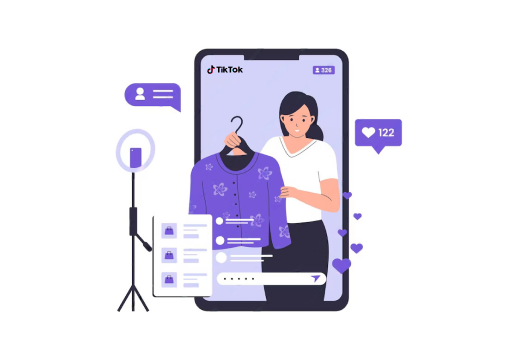In the digital age, the landscape of retail has dramatically shifted. No longer are brick-and-mortar stores the only avenue for businesses to reach their audience. With the rise of social media platforms, e-commerce has evolved into an interactive, dynamic, and visually driven marketplace. For e-commerce and small business owners, social media presence for business is an unprecedented opportunity to increase visibility, connect with customers, and drive sales.
Social media marketing, specifically through social selling, is no longer just an optional strategy—it’s a crucial component of any modern business plan. Whether you’re selling fashion, beauty products, tech gadgets, or handmade crafts, platforms like Instagram, Facebook, TikTok, YouTube, and Pinterest offer powerful tools to reach your target audience and boost sales.
In this blog, we’ll discuss the best practices for selling on social media platforms, giving you the knowledge and tools to leverage these platforms effectively to meet your business goals.
Choosing the Right Social Media Platforms for Selling
Choosing the right social media platform to sell on can make or break your business’s success in the online space. It’s not just about being present on every platform; it’s about being where your audience is in the format that resonates most with them.
Before you dive into selling, analyze the demographics of each platform and match them with your product’s appeal. Here are some key points to consider when selecting the best social media platform for selling products:
- Audience Demographics: Who are you selling to? Different platforms attract different age groups, interests, and even spending behaviors.
- Product Types: Certain platforms are better suited for different types of products. For example, visually appealing products do well on Instagram, while tech and lifestyle brands may find more success on YouTube.
- Engagement Features: Consider the features of each platform that enhance selling, such as Instagram Shopping, Pinterest Pins, or TikTok’s viral challenges.
Top Platforms for Social Selling
- Instagram: Ideal for businesses with visually appealing products. From fashion to food, Instagram’s image-centric platform is perfect for showcasing your brand.
- Facebook: With over 2.8 billion active users, Facebook offers a broad demographic reach. It’s an excellent platform for creating a community and selling to a broad audience.
- TikTok: Known for its viral content, TikTok is perfect for brands targeting a younger demographic. The focus here is on creative, engaging videos.
- Pinterest: Ideal for businesses in fashion, home décor, beauty, or DIY products, Pinterest acts as a powerful visual search engine.
- YouTube: Perfect for businesses that rely on product demonstrations or storytelling. YouTube allows for in-depth content that educates customers and drives conversions.
How to Sell on Facebook
Facebook remains one of the most powerful selling platforms thanks to its broad user base, comprehensive advertising tools, and versatile features for businesses. Whether you’re promoting products through posts, running targeted ads, or engaging with potential customers through Facebook Groups, the platform offers numerous ways to drive sales.
- Setting Up a Business Profile: Create a Facebook Business Page. Unlike personal profiles, business pages give you access to valuable features like insights, ads, and e-commerce integrations. Ensure your profile has a compelling brand story, high-quality images, and all relevant business information. In the “About” section, you can also link to your website or online store to direct traffic there.
- Using Facebook Shop: Facebook Shop allows businesses to set up a virtual storefront on the platform. You can showcase your products directly in a customized shop section, where users can browse and purchase without leaving Facebook. Make sure to categorize your products and include detailed descriptions and prices to enhance the shopping experience.
- Running Facebook Ads: Facebook’s advertising tools are highly targeted, making it easier for businesses to reach potential customers. You can create various ad types, such as photos, videos, carousels, and dynamic product ads. These ads can appear in users’ news feeds, the right-hand sidebar, and even Instagram, giving you extensive reach. Using compelling visuals and strong calls to action is key to driving conversions.
- Engagement Strategies: Facebook is a social platform, so interaction is essential. Engage with your audience through comments, direct messages, and Facebook Live. Hosting live streams where you showcase your products, answer questions, or run special promotions can significantly increase visibility and sales. Regularly posting engaging content, running giveaways, and offering exclusive deals can also help build a loyal following.

How to Sell on Instagram
Instagram is one of the top social media platforms for selling. Its visual nature and in-app shopping features make it a seamless experience for both businesses and customers.
- Setting Up a Business Account: To get started, you’ll need to convert your personal Instagram account into a business profile. This gives you access to analytical tools, paid advertising options, and the ability to add links to your posts and stories. A compelling bio is essential—use this space to tell your brand’s story and provide a link to your website or e-commerce store.
- Using Instagram Shopping: Instagram Shopping is a game-changer for social media sales. By tagging your products in photos and videos, users can tap on the product to view its price and purchase directly within the app. This creates a streamlined shopping experience and reduces friction in the buying process.
- Leveraging Instagram Ads: Instagram ads are a powerful way to promote your products directly to a targeted audience. You can create photo ads, video ads, carousel ads, and even story ads. Make sure your visuals are high-quality, and pair them with compelling calls to action (CTAs) to drive clicks and conversions.
- Engagement Strategies: Social media is all about interaction. Engage with your followers by replying to comments, direct messages, and hosting live sessions. Posting regularly and creating content that resonates with your audience is key to maintaining engagement and building brand loyalty.
How to Sell on TikTok
TikTok is a platform fueled by creativity and user engagement, making it a goldmine for viral marketing. With TikTok’s short-form videos and algorithm-driven content discovery, businesses can create engaging, highly shareable content.
- Creating Engaging Content: To succeed on TikTok, you need to create videos that grab attention in the first few seconds. Embrace trends, use popular sounds, and incorporate humor or storytelling. TikTok users love organic content, so avoid making your videos feel like traditional ads.
- TikTok Shopping: TikTok has integrated shopping features that allow you to sell directly from the app. You can link your product catalog to your TikTok account, enabling users to browse and purchase items without leaving the platform.
- TikTok Ads: In addition to organic content, you can use TikTok’s ad platform to reach even more people. From in-feed ads to branded hashtag challenges, there are various formats to experiment with. The key to successful TikTok ads is creating content that feels native to the platform.
How to Sell on YouTube
YouTube is the go-to platform for long-form, in-depth content. If your product requires explanation or demonstration, YouTube is the ideal platform to showcase its features and benefits.
- Setting Up a Channel for Business: To begin selling on YouTube, set up a dedicated business channel. Optimize your channel’s branding, description, and contact information so viewers immediately understand what your business offers.
- Using YouTube for Product Demonstrations: Create product demonstration videos, tutorials, and unboxings that show your products in action. This helps potential customers understand the value of your products and increases the likelihood of a purchase.
- Monetization and Sales through YouTube: While YouTube doesn’t have native e-commerce features like Instagram or TikTok, you can still drive traffic to your e-commerce site by including links in your video descriptions. You can also use YouTube ads to promote your products further.
How to Sell on Pinterest
Pinterest is a visual search engine that allows users to discover and get inspired by products. It’s a platform that’s incredibly powerful for driving traffic to your website and increasing sales, especially for fashion, beauty, and lifestyle brands.
- Creating a Business Account: Start by setting up a Pinterest Business account. This will give you access to analytics and paid advertising tools to help you track performance and reach more people.
- Using Rich Pins: Rich Pins provide more detailed information about your products directly on the pin itself. This additional context helps users make quicker purchasing decisions and increases your engagement.
- Pinterest as a Sales Funnel: Use Pinterest’s sales funnel by crafting pins that attract attention and encourage users to click through to your website. Pins should link directly to product pages, leading to higher conversion rates.
Social Selling vs. Social Commerce
It’s essential to understand the difference between social selling and social commerce. While social selling focuses on relationship-building to influence purchase decisions, social commerce allows businesses to sell directly within the social platform itself. Both strategies are vital for success, and understanding when and how to use each is key to maximizing your social media marketing efforts.
Selling on Social Media FAQ
Tackle common questions with actionable answers, helping business owners navigate the complexities of social media selling effectively.
Selling products on social media is more than just a trend—it’s a necessity for small and e-commerce businesses in today’s digital-first world. By selecting the right platform and implementing the right social media sales strategy, you can tap into a wealth of opportunities to increase brand awareness and drive sales.
Remember that social selling requires patience and adaptation. To achieve success, analyze your results, engage with your audience, and continuously refine your approach. With the right tactics, you can turn social media into a powerful tool for growing your business.
If you need personalized advice on how to sell on social media, feel free to contact us at SMM Trigger for a free consultation. We’re here to help you succeed in social media marketing!
By using social media to its full potential, you can revolutionize the way you connect with customers and boost your sales.







